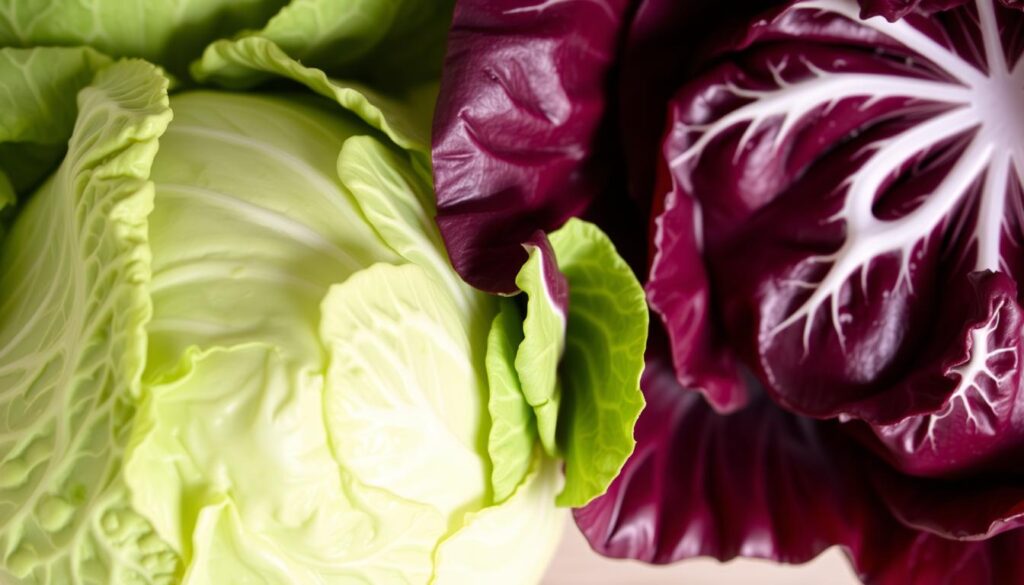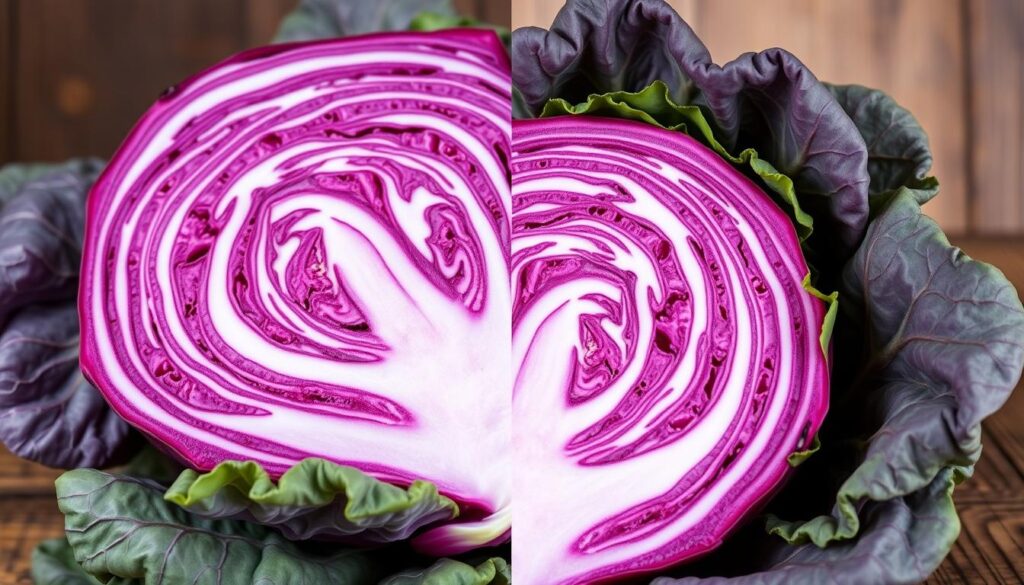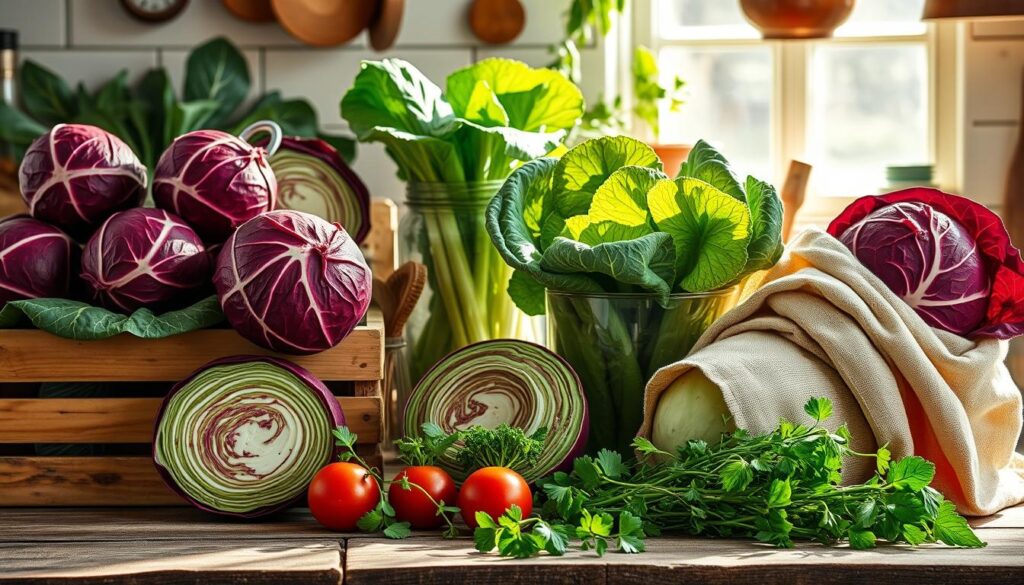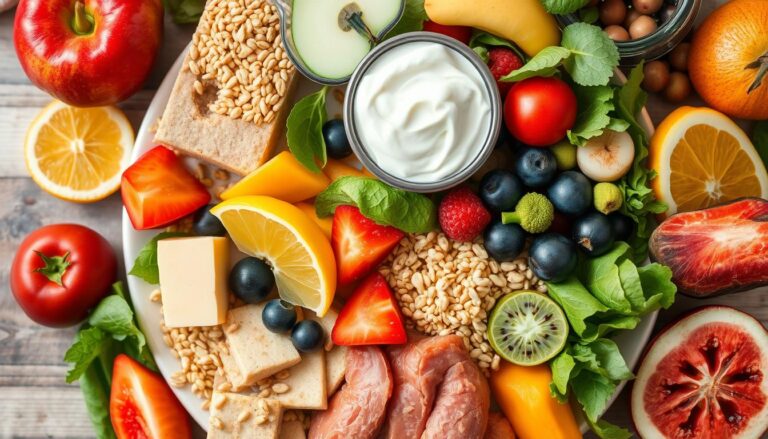Cabbage is no longer seen as a boring, smelly vegetable. It’s making a comeback in cooking. Green and red (or purple) cabbage have different tastes, textures, and health benefits. Choosing between them can change how your dishes turn out, from colorful coleslaws to tasty sides.
Key Takeaways
- Red cabbage contains 10 times more Vitamin A than green cabbage.
- Red cabbage has 37% more Vitamin C than green cabbage.
- Green cabbage provides significantly more Vitamin K than red cabbage.
- Anthocyanins in red cabbage offer cancer-fighting and memory-boosting benefits.
- Proper storage can extend the shelf life of both green and red cabbage.
The Underappreciated Brassica
Cabbage’s Unfair Reputation and Rediscovered Love
Cabbage, a part of the brassica oleracea family, has been overlooked for too long. It’s often seen as less exciting than broccoli or kale. But, many are now seeing its true value and taste.
Chef Abra Berens used to doubt cabbage, remembering a place in Nice, France that smelled of boiled cabbage. But now, she loves cabbage for its many uses and health benefits. She calls it a “hustler of a vegetable” that deserves more love in the kitchen.
“Cabbage has long been an underappreciated vegetable, often overshadowed by its stronger-flavored cousins like broccoli and kale.”
Cabbage may not look as appealing as some brassica veggies. But, it’s full of possibilities in the kitchen. From red cabbage’s bright colors to Savoy’s crisp texture, it’s a hidden gem.

As chefs and home cooks explore cabbage, its bad reputation is fading. Its rich history and untapped potential are making it a favorite again. Cabbage is ready to be a key part of our diets once more.
Green Cabbage vs. Red Cabbage: What’s the Difference?
Taste, Color, and Nutritional Variations
Green cabbage and red cabbage look similar but taste and look different. Green cabbage tastes milder and sweeter. Red cabbage, or purple cabbage, has a peppery taste. The main difference is red cabbage’s deep purple-red color, packed with more vitamin C and beta-carotene than green cabbage.
The nutritional differences affect how they’re used in cooking. Red cabbage is smaller and denser, with a peppier taste. Eating red cabbage regularly can help lower blood pressure and reduce heart disease risk.
Green cabbage is rich in vitamin K, calcium, magnesium, and zinc for strong bones. All cabbages are full of fiber, which is good for your gut. They’re also low in calories and high in water and fiber, helping with weight loss.

“Cabbage and related vegetables are believed to play a role in preventing colorectal cancer.”
Choosing between green cabbage and red cabbage means picking a healthy choice. Each has its own taste, color, and nutritional benefits. These benefits can guide how you use them in cooking.
Picking the Perfect Head
Size, Density, and Freshness Indicators
When picking a cabbage, size, density, and freshness matter. Look for a large, heavy head. The bigger it is, the longer it lasts. A dense, tightly packed head means it’s full of water and will keep longer.
Check the underside for black veining. This can mean the cabbage is older and less fresh. Also, make sure the outer leaves aren’t wilted or damaged. This is especially important if you plan to use it raw.
The cabbage’s freshness is key for its crunch and flavor. So, pay close attention to these signs when choosing.
| Cabbage Characteristic | Indicator of Quality |
|---|---|
| Size | Larger heads tend to last longer |
| Density | Tightly packed, dense heads have higher water content and longer shelf life |
| Freshness | Avoid cabbage with black veining or wilted, damaged outer leaves |

By considering these factors, you can pick the best cabbage for your recipes. This ensures you get a high-quality, long-lasting head.
Red cabbage or Green Cabbage? Choosing for Your Dish
Choosing between green and red cabbage depends on the dish’s color and look. Red cabbage’s bright color makes it great for dishes that need to stand out. Green cabbage, on the other hand, is a blank slate for other flavors to take center stage.
Texture also matters. Green cabbage gets softer and silkier when cooked. Red cabbage might look a bit bruised or wilted. For salads and slaws, green cabbage is better to avoid color changes.
The right choice depends on how the cabbage fits with the dish’s flavors and textures. Red cabbage’s rich taste and vitamin A might be perfect for some recipes. Green cabbage’s mild flavor and smooth texture are better for others.
| Characteristic | Green Cabbage | Red Cabbage |
|---|---|---|
| Color | Pale green | Deep purple-red |
| Taste | Mild, sweet | Slightly peppery, stronger flavor |
| Texture | Crisp, crunchy | Slightly tougher, can become bruised |
| Nutrients | Good source of vitamins C and K | Higher in vitamin A, C, and antioxidants |
Understanding the differences between green and red cabbage helps cooks choose the best for their recipes. This ensures the dish turns out as desired.

Storage Tips for Longevity
Cabbage is a tough vegetable that can stay fresh for weeks in the fridge. To keep it fresh, store it whole as much as you can. Only cut what you plan to eat right away.
Wrap the cabbage tightly in plastic to keep moisture in. This trick works for both green and red cabbage. It can last 2-3 weeks or up to 2 months. This makes cabbage a great ingredient to have around, ready for any dish.
Don’t wash cabbage before storing it. Too much water can make it spoil faster. Store it in a hydrator drawer or a bag with holes to keep it moist.
If you’ve used part of the cabbage, wrap the rest in plastic wrap. This keeps it fresh. Using these storage tips can help your cabbage last longer.
“Cutting into cabbage causes it to lose vitamin C, leading to faster spoilage. Handling cabbage with care is essential as any kind of cell damage can degrade the vitamin C content and reduce its shelf life.”
With a few easy storage tips, you can make your cabbage last longer. This way, you’ll always have it ready for your meals.

The Classic Coleslaw Base
Coleslaw is a quintessential summer dish that showcases the crunchy texture and mild flavor of green cabbage. Green cabbage is the most common and recommended choice for making a classic coleslaw. Its neutral taste allows the dressing and other mix-ins to shine, creating a well-balanced slaw. The crisp, dense leaves of green cabbage also provide the perfect textural contrast to creamy or tangy coleslaw dressings.
Green Cabbage: The Mild-Mannered Canvas
Green cabbage is the most budget-friendly and widely available variety, making it an ideal choice for coleslaw. Its mild flavor profile serves as a blank canvas, allowing the dressing to take center stage. Unlike its bolder counterparts, such as red or Savoy cabbage, green cabbage won’t overpower the other ingredients in your slaw.
To create a classic coleslaw, you’ll need the following key elements:
- 1 medium green cabbage (about 2 pounds), thinly shredded
- 3 medium carrots, peeled and shredded
- 1/2 cup of fresh parsley leaves, coarsely chopped
- 1 cup (225g) of creamy mayonnaise-based dressing
- 2 tablespoons of apple cider vinegar
- 2 tablespoons of Dijon mustard
- 1 teaspoon of celery seeds
- Salt and pepper to taste
According to our research, this easy creamy coleslaw recipe has an average rating of 4.9 out of 5 stars from 141 reviews, making it a crowd-pleasing favorite.
| Ingredient | Quantity |
|---|---|
| Green Cabbage | 1 medium (about 2 pounds) |
| Carrots, peeled and shredded | 3 medium |
| Fresh Parsley, coarsely chopped | 1/2 cup (loosely packed) |
| Mayonnaise | 1 cup (225g) |
| Apple Cider Vinegar | 2 tablespoons |
| Dijon Mustard | 2 tablespoons |
| Celery Seeds | 1 teaspoon |
| Salt and Pepper | To taste |
The key to a perfectly textured coleslaw is in the preparation. Salting the shredded cabbage and carrots for a quick five-minute purge helps remove excess moisture, preventing a soggy slaw. Drying the purged and rinsed cabbage on towels also preserves its crunchy texture and fresh flavor.
With its mild taste and sturdy texture, green cabbage is the ideal foundation for building a classic coleslaw that will delight your taste buds all summer long.
Exploring Cabbage Varieties
Green and red cabbage are common, but there’s more to the cabbage family. You’ll find everything from sweet Napa cabbage to earthy Savoy cabbage. Each variety brings its own flavor to the table.
Green, Red, Napa, and Savoy Cabbages
Napa cabbage is known for its mild taste and tender leaves. It’s perfect for salads and stir-fries. Savoy cabbage, with its crinkly leaves, adds an earthy flavor to soups and braises.
There are many more cabbages out there. Red cabbage adds a pop of color, while Deadon cabbage is a favorite in Korean cooking. These cabbages offer endless ways to spice up your meals.
| Cabbage Variety | Taste Profile | Culinary Applications |
|---|---|---|
| Green Cabbage | Mild, crunchy | Slaws, stir-fries, roasted |
| Red Cabbage | Sweet, earthy | Braises, pickles, coleslaws |
| Napa Cabbage | Sweet, tender | Salads, stir-fries, wraps |
| Savoy Cabbage | Earthy, soft | Soups, braises, stuffed dishes |
Exploring cabbage varieties opens up a world of flavors and textures. Whether you’re making a classic coleslaw or trying something new, these veggies will make your dishes exciting.
Versatile Cabbage Recipes
Cabbage is great in many dishes, from coleslaw to roasted meals. Green cabbage is perfect for salads because of its mild taste and crisp texture. Red cabbage adds color and a peppery flavor to dishes.
It’s also good for cooking methods like sautéing and roasting. This makes cabbage a great choice for soups and stir-fries.
Discover the wide range of cabbage recipes with these tasty options:
- Sautéed Cabbage: A simple yet flavorful dish that calls for a small head of green cabbage, weighing about 1½ pounds.
- Cabbage Soup: This hearty soup is a great way to use a whole head of cabbage in one go.
- Cabbage Steaks: These crisp, golden-brown edged cabbage steaks with a tender middle are a delightful vegetable-based main dish.
- Okonomiyaki: This savory Japanese pancake, featuring cabbage as a key ingredient, has garnered over 100 5-star reviews, indicating high satisfaction among readers.
- Cabbage Salad: One of the author’s all-time favorite cabbage recipes, this salad showcases the versatility of this cruciferous vegetable.
Looking for a meatless option? Try the Buffalo Cauliflower Tacos. They turn a game day snack into a filling taco. The Mango Ginger Rice Bowl also works well with any cabbage variety.
For a unique taste, try the Sweet Potato Chili Fries. They pair sweet potato wedges with a zesty cabbage slaw. The BBQ Jackfruit Sandwich is a vegan alternative to pulled chicken or pork, topped with a crisp cabbage slaw.
Most of the cabbage recipes are vegetarian-friendly. They use ingredients like bacon, mushroom gravy, and coconut milk. There’s a cabbage dish for everyone, no matter your taste or diet.
Conclusion
Cabbage is getting more love from chefs and home cooks. They see its amazing versatility and health perks. Whether you like green cabbage for its mild taste or red cabbage for its bold color, there’s a lot you can do with it.
Knowing how to pick and store cabbage can open up new cooking possibilities. This lets you explore more in the kitchen.
Cabbage is full of good stuff like vitamins, antioxidants, and fiber. Eating it can help lower disease risk, improve digestion, and boost heart health. It’s great in many dishes, from coleslaw to salads and soups.
When picking cabbage, think about what you need. Green, red, Napa, and Savoy cabbages each have their own charm. Storing it right keeps it fresh for longer, so you can enjoy its taste and health benefits for weeks.
Give cabbage a try and see how it can make your meals better. It’s a simple way to nourish your body with delicious food.





